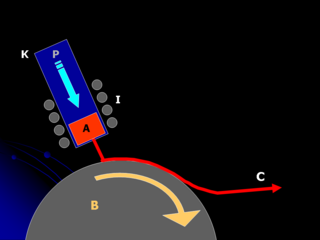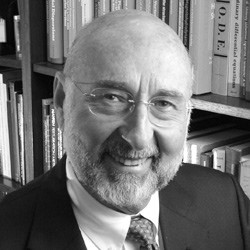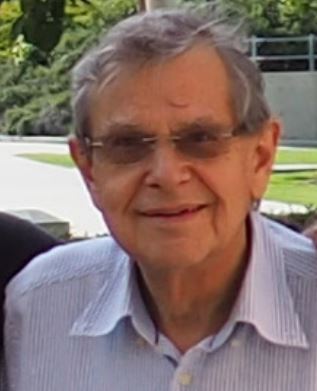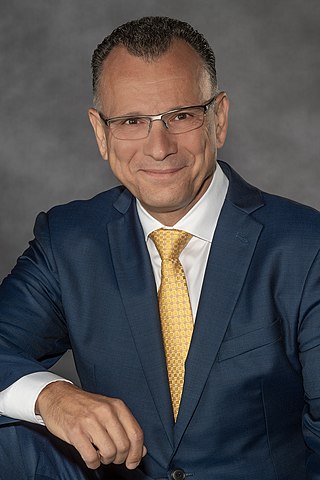Related Research Articles

In fluid dynamics, vortex-induced vibrations (VIV) are motions induced on bodies interacting with an external fluid flow, produced by, or the motion producing, periodic irregularities on this flow.

Howard Alvin Stone is the Donald R. Dixon '69 and Elizabeth W. Dixon Professor in Mechanical and Aerospace Engineering at Princeton University. His field of research is in fluid mechanics, chemical engineering and complex fluids. He became an Editor of the Annual Review of Fluid Mechanics in 2021.

Melt spinning is a metal forming technique that is typically used to form thin ribbons of metal or alloys with a particular atomic structure.
Anatol Roshko was a Canadian-born physicist and engineer. He was the Theodore von Kármán Professor of Aeronautics, Emeritus, at the California Institute of Technology, Pasadena, CA.

Jakob Ackeret, FRAeS was a Swiss aeronautical engineer. He is widely viewed as one of the foremost aeronautics experts of the 20th century.
John Leask Lumley was an American fluid dynamicist and a professor at Cornell University. He is widely known for his research in turbulence and is the coauthor of A First Course in Turbulence along with Hendrik Tennekes.

Stephen Howard Davis was an American applied mathematician working in the fields of fluid mechanics and materials science. Davis was the McCormick School Institute Professor and the Walter P. Murphy Professor of Applied Mathematics at Northwestern University. Davis has been listed as an ISI Highly Cited researcher in Engineering. His work was acknowledged in festschrifts in 2002.

William Craig Reynolds was a fluid physicist and mechanical engineer who specialized in turbulent flow and computational fluid dynamics.
John Michael Prausnitz is a professor of chemical engineering at the University of California, Berkeley, a position he has held since 1955.
Dimensionless numbers have an important role in analyzing the behavior of fluids and their flow as well as in other transport phenomena. They include the Reynolds and the Mach numbers, which describe as ratios the relative magnitude of fluid and physical system characteristics, such as density, viscosity, speed of sound, and flow speed. To compare a real situation with a small-scale model it is necessary to keep the important characteristic numbers the same. Names and formulation of these numbers were standardized in ISO 31-12 and in ISO 80000-11.

John Francis Brady is an American chemical engineer and the Chevron Professor of Chemical Engineering and Mechanical Engineering at the California Institute of Technology. He is a fluid mechanician and creator of the Stokesian dynamics method for simulating suspensions of spheres and ellipsoids in low Reynolds number flows. He is an elected fellow of the American Physical Society, a fellow of the Society of Rheology, as well as a member of the National Academy of Sciences, the National Academy of Engineering, and the American Academy of Arts and Sciences.

Forman Arthur Williams is an American academic in the field of combustion and aerospace engineering who is Emeritus Professor of Mechanical and Aerospace Engineering at the University of California San Diego.

Charles Meneveau is a French-Chilean born American fluid dynamicist, known for his work on turbulence, including turbulence modeling and computational fluid dynamics.

Fotis Sotiropoulos is a Greek-born American engineering professor and university administrator known for his research contributions in computational fluid dynamics for river hydrodynamics, renewable energy, biomedical and biological applications. He currently serves as the Provost and Senior Vice President for Academic Affairs of Virginia Commonwealth University, a position he has held since August 1, 2021
Ravindra Nath Sudan was an Indian-American electrical engineer and physicist who specialized in plasma physics. He was known for independently discovering the whistler instability in 1963, an instability which causes audible low-frequency radio waves to be emitted in the magnetosphere in the form of whistler waves. He also pioneered the study of the generation and propagation of intense ion beams, and contributed to theories of plasma instabilities and plasma turbulence.
Lydia Bourouiba is an Esther and Harold E. Edgerton Professor, an Associate Professor in the Civil and Environmental Engineering and Mechanical Engineering departments, and in the Institute for Medical Engineering and Science at the Massachusetts Institute of Technology. She is also a Harvard-MIT Health Sciences and Technology Faculty, and Affiliate Faculty of Harvard Medical School. She directs the Fluid Dynamics of Disease Transmission Laboratory at MIT.
Ronald G. Larson is George G. Brown Professor of Chemical Engineering and Alfred H. White Distinguished University Professor at the University of Michigan, where he holds joint appointments in macromolecular science and engineering, biomedical engineering, and mechanical engineering. He is internationally recognized for his research contributions to the fields of polymer physics and complex fluid rheology, especially in the development of theory and computational simulations. Notably, Larson and collaborators discovered new types of viscoelastic instabilities for polymer molecules and developed predictive theories for their flow behavior. He has written numerous scientific papers and two books on these subjects, including a 1998 textbook, “The Structure and Rheology of Complex Fluids”.
Sandra Marina Troian is an American applied physicist known for her research on fluid dynamics, quasicrystals, surface science, thin films, microfluidics, and spacecraft micropropulsion. She is a professor of Applied Physics, Aeronautics, and Mechanical Engineering in the Division of Engineering and Applied Science of the California Institute of Technology (Caltech), and head of the Laboratory of Interfacial and Small Scale Transport in the Department of Applied Physics and Materials Science at Caltech.
Lynn Walker is a professor of chemical engineering at Carnegie Mellon University. Her research considers the rheology of complex fluids and how nanostructure impacts the behavior of complex systems. She is a Fellow of the American Institute of Chemical Engineers, the Society of Rheology, and the American Physical Society.
Shelley Lynn Anna is an American chemical engineer and experimental fluid dynamics researcher who studies droplets, multiphase flow, and the effects of surfactants in microfluidics, the rheology of extensional and interfacial flows, and microscale transport. She is a professor of chemical engineering and associate dean for faculty and graduate affairs and strategic initiatives in the Carnegie Mellon University College of Engineering.
References
- ↑ Bostwick, J.B.; Steen, P.H. (2014). "Stability of Constrained Capillary Surfaces". Annual Review of Fluid Mechanics. 47: 539–68. doi: 10.1146/annurev-fluid-010814-013626 .
- ↑ Steen, PH, CT Chang and JB Bostwick, (2019) “Droplet motions fill a periodic table,” Proc. Natl. Acad. Sci., https://doi.org/10.1073/pnas.1817065116
- ↑ Lefkowitz, Melanie. "A new periodic table classifies droplet motions" http://news.cornell.edu/stories/2019/02/new-periodic-table-classifies-droplet-motions
- ↑ 4 Awesome Discoveries You Probably Didn’t Hear About This Week - Episode 24 (Discovery 2) https://www.youtube.com/watch?v=J1n2LoJIoA0&feature=youtu.be
- ↑ Drummond, Katie. "Pentagon Funds Spider-Man Tech for Real-Life Wall Crawlers". Wired. Permalink. Retrieved 14 October 2014.
- ↑ Tech Briefs. "Here's an Idea: Engineering Real-Life 'Superpowers'" https://www.techbriefs.com/component/content/article/tb/webcasts/podcasts/32382
- ↑ Steen, Paul; Karcher, Christian (1997). "Fluid Mechanics of Spin Casting of Metals". Annual Review of Fluid Mechanics. 29: 373–97. Bibcode:1997AnRFM..29..373S. doi:10.1146/annurev.fluid.29.1.373.
- ↑ US Patent 7,306,025 (2007), “Methods for continuous casting of a molten material” https://patents.google.com/patent/US7306025B2/en
- ↑ US Patent 7,082,986 (2006), “System & method for continuous casting of a molten material” https://patents.google.com/patent/US7082986
- ↑ "APS Fellows Directory" https://www.aps.org/programs/honors/fellowships/archive-all.cfm
- ↑ "AIChE Fellows Directory". www.aiche.org. American Institute of Chemical Engineers.
- ↑ "Paul H. Steen, CBE Professor, passes away unexpectedly | Smith School of Chemical and Biomolecular Engineering". www.cheme.cornell.edu. Retrieved 2020-09-09.